Chapter 8

To help you keep your daily life organized, your iMac includes the Calendar, Contacts, Reminders, and Maps apps.
Subscribe to a Published Calendar
Change a Contact’s Information
Keep Track of Tasks with Reminders
Navigate the Calendar App
The Calendar app enables you to input your appointments and events and track them easily. After launching the app, you can navigate to the dates with which you need to work.
Calendar has a streamlined user interface that makes it easy to move among days, weeks, months, and years. You can click the Today button to display the current day, or use the Go to Date dialog to jump directly to a specific date.
Navigate the Calendar App
Open Calendar and Navigate by Days
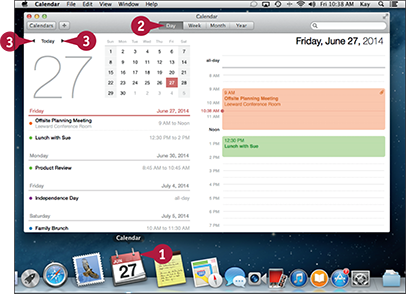
![]() Click Calendar (
Click Calendar (![]() ) on the Dock.
) on the Dock.
Calendar opens.
![]() Click Day.
Click Day.
Calendar displays the current day, including a schedule of the day’s events.
![]() Click Next (
Click Next (![]() ) to move to the next day or Previous (
) to move to the next day or Previous (![]() ) to move to the previous day.
) to move to the previous day.
Calendar displays the day you chose.
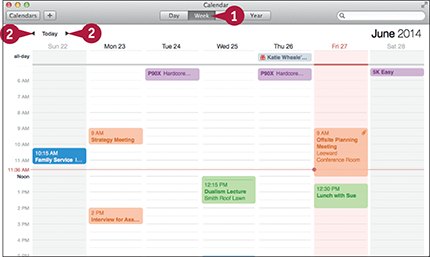
![]() Click Week.
Click Week.
Calendar displays the week for the date you were previously viewing.
![]() Click Next (
Click Next (![]() ) to move to the next week or Previous (
) to move to the next week or Previous (![]() ) to move to the previous week.
) to move to the previous week.
Calendar displays the week you chose.
View and Navigate by Months
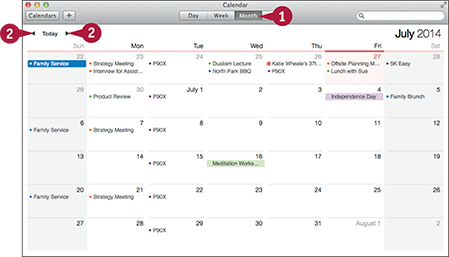
![]() Click Month.
Click Month.
Calendar displays the current month.
![]() Click Next (
Click Next (![]() ) to move to the next month or Previous (
) to move to the next month or Previous (![]() ) to move to the previous month.
) to move to the previous month.
Calendar displays the month you chose.

![]() Click Year.
Click Year.
Calendar displays the year for the date you were last viewing.
![]() Click Next (
Click Next (![]() ) to move to the next year or Previous (
) to move to the next year or Previous (![]() ) to move to the previous year.
) to move to the previous year.
Calendar displays the year you chose.
Note: In Week view, Month view, or Year view, double-click a day to display it in Day view.
A You can click Today to display today’s date.
Create a New Calendar
Calendar enables you to create as many calendars as you need to separate your appointments into logical categories. Calendar comes with two calendars already created for you: the Home calendar and the Work calendar. You can create new calendars as needed alongside these calendars.
After creating a new calendar, you can create events in it. You can also change existing events from another calendar to the new calendar.
Create a New Calendar

![]() In Calendar, click File.
In Calendar, click File.
The File menu opens.
![]() Click New Calendar.
Click New Calendar.
Note: If the Calendars pane is open, you can create a new calendar by pressing ![]() +clicking in open space in the Calendars pane and then clicking New Calendar on the contextual menu.
+clicking in open space in the Calendars pane and then clicking New Calendar on the contextual menu.
Calendar displays the Calendars pane if it was hidden.
Calendar creates a new calendar and displays an edit box around its default name, Untitled.
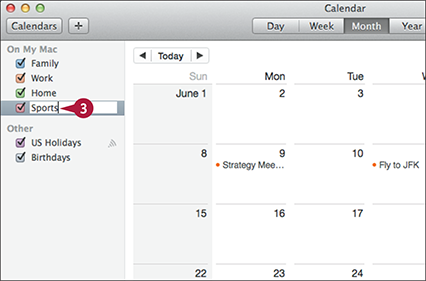
![]() Type the name for the calendar and press
Type the name for the calendar and press ![]() .
.
Calendar applies the name to the calendar.
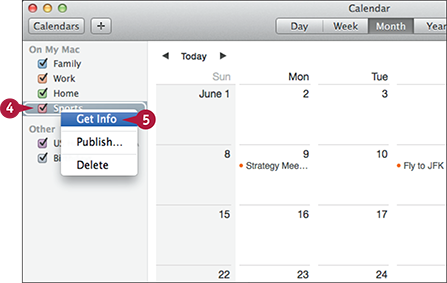
![]() Press
Press ![]() +click the calendar’s name.
+click the calendar’s name.
The contextual menu opens.
![]() Click Get Info.
Click Get Info.
A dialog opens showing information for the calendar.
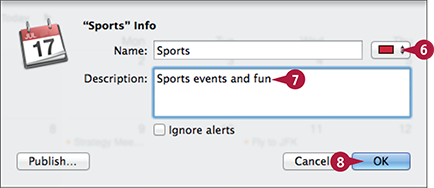
![]() Click the Color pop-up menu (
Click the Color pop-up menu (![]() ) and then select the color you want the calendar to use.
) and then select the color you want the calendar to use.
![]() Type a description for the calendar.
Type a description for the calendar.
Note: Click Ignore alerts (![]() changes to
changes to ![]() ) if you want to suppress alerts for the calendar.
) if you want to suppress alerts for the calendar.
![]() Click OK.
Click OK.
The dialog closes.
You can now add events to the calendar.
Create an Event
Calendar makes it easy to organize your time commitments by creating an event for each appointment, meeting, trip, or special occasion. Calendar displays each event as an item on its grid, so you can see what is supposed to happen when.
You can create an event either for a specific length of time, such as one or two hours, or for an entire day. And you can create either an appointment that occurs only once or an appointment that repeats one or more times, as needed.
Create an Event
![]() Navigate by days, weeks, months, or years to reach the day on which you want to create the event.
Navigate by days, weeks, months, or years to reach the day on which you want to create the event.
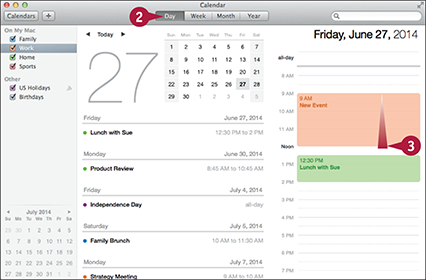
![]() If the appointments area is in Month view or Year view, click Day to switch to Day view or Week to switch to Week view.
If the appointments area is in Month view or Year view, click Day to switch to Day view or Week to switch to Week view.
![]() In the appointments area, click the time the event starts, and then drag to the time at which it ends.
In the appointments area, click the time the event starts, and then drag to the time at which it ends.
Calendar creates an event where you clicked and applies a default name, New Event.
When you release the mouse button, a pop-up panel appears.

![]() Type the name for the event and then press
Type the name for the event and then press ![]() .
.
![]() Click the Color pop-up menu and select the color for the event.
Click the Color pop-up menu and select the color for the event.
![]() Click location and type the location for the event.
Click location and type the location for the event.
![]() Click Add Alert, Repeat, or Travel Time.
Click Add Alert, Repeat, or Travel Time.
Controls for setting the alert, repeat, and travel time appear.
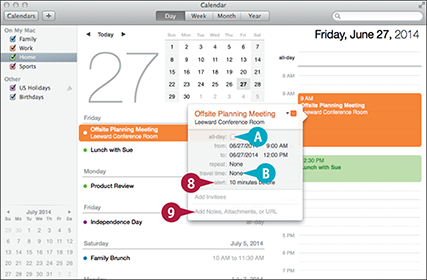
A You can click all-day (![]() changes to
changes to ![]() ) to make the event an all-day event.
) to make the event an all-day event.
B You can click travel time and specify the travel time required.
![]() If you want a reminder, click alert and specify the details of the alert, such as 10 minutes before.
If you want a reminder, click alert and specify the details of the alert, such as 10 minutes before.
![]() To add further information, click Add Notes, Attachments, or URL.
To add further information, click Add Notes, Attachments, or URL.

![]() Click Add Note and type any notes needed.
Click Add Note and type any notes needed.
![]() Click Add Attachment, click the file in the Open dialog, and then click Open.
Click Add Attachment, click the file in the Open dialog, and then click Open.
![]() Click Add URL and type or paste the URL for the event.
Click Add URL and type or paste the URL for the event.
![]() Click outside the event panel.
Click outside the event panel.
The panel closes.
The event appears in your calendar.
Share a Calendar
Calendar enables you to share one or more calendars with other people so that they know when you are busy.
Your calendars stored on iCloud sync automatically to your other Macs and iOS devices. You can share a calendar stored on iCloud either as a private calendar, available only to the people whose names or e-mail addresses you specify, or as a public calendar, available to everyone. If you store your calendar on your iMac, you can share that calendar with others by publishing it to a calendar server on the Internet.
Share a Calendar
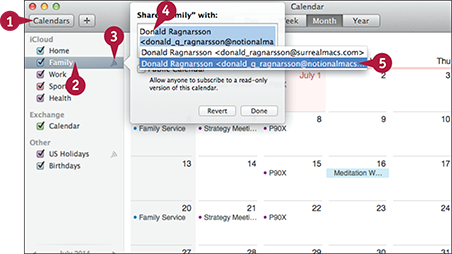
![]() In Calendar, click Calendars.
In Calendar, click Calendars.
![]() Position the mouse pointer over the calendar.
Position the mouse pointer over the calendar.
The Share icon (![]() ) appears.
) appears.
![]() Click Share (
Click Share (![]() ).
).
The Share dialog opens.
![]() Start typing a name or e-mail address.
Start typing a name or e-mail address.
![]() Double-click the e-mail address for the contact.
Double-click the e-mail address for the contact.
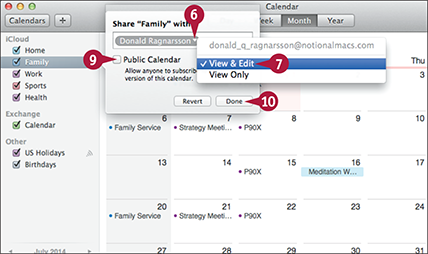
![]() Click the pop-up button (
Click the pop-up button (![]() ).
).
![]() Click View & Edit to enable the contact to edit the calendar. Click View Only to enable the contact to only view the calendar.
Click View & Edit to enable the contact to edit the calendar. Click View Only to enable the contact to only view the calendar.
![]() Add other contacts as needed by repeating steps 4 to 7.
Add other contacts as needed by repeating steps 4 to 7.
![]() Click Public Calendar (
Click Public Calendar (![]() changes to
changes to ![]() ) if you want to make the calendar public.
) if you want to make the calendar public.
![]() Click Done.
Click Done.
Calendar shares the calendar.
Publish a Calendar Stored on Your iMac
Note: Publishing a calendar makes it public, available to anyone who can access the calendar server that hosts it. Only you can edit your public calendars.
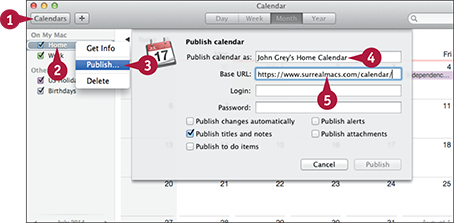
![]() In Calendar, click Calendars.
In Calendar, click Calendars.
The Calendars panel appears.
![]() Press
Press ![]() +click the calendar you want to share.
+click the calendar you want to share.
The contextual menu opens.
![]() Click Publish.
Click Publish.
The Publish calendar dialog opens.
![]() Type a descriptive name for the calendar.
Type a descriptive name for the calendar.
![]() Type or paste the URL for the calendar server.
Type or paste the URL for the calendar server.
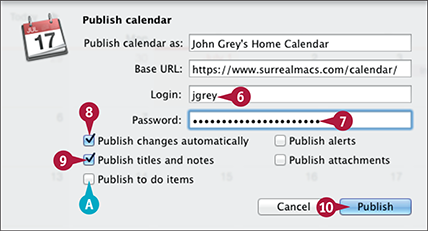
![]() Type your login name.
Type your login name.
![]() Type your password.
Type your password.
![]() Click Publish changes automatically (
Click Publish changes automatically (![]() changes to
changes to ![]() ) to publish calendar changes automatically.
) to publish calendar changes automatically.
![]() Click Publish titles and notes (
Click Publish titles and notes (![]() changes to
changes to ![]() ) to publish brief details of your events.
) to publish brief details of your events.
A You can click Publish to do items (![]() changes to
changes to ![]() ) to include your to-do items.
) to include your to-do items.
![]() Click Publish.
Click Publish.
Calendar publishes the calendar.
Subscribe to a Published Calendar
Calendar enables you to subscribe to calendars that others have published on iCloud or the Internet. By subscribing to a calendar, you add it to Calendar so that you can view the events in the calendar along with those in your calendars.
You can subscribe to a calendar either by typing or pasting its URL into Calendar or by clicking a link in a message that you have received.
Subscribe to a Published Calendar

![]() In Calendar, click File.
In Calendar, click File.
The File menu opens.
![]() Click New Calendar Subscription.
Click New Calendar Subscription.
Note: Many organizations, sports teams, and artists make their calendars available on their websites. You can either copy the calendar’s URL or download the calendar.
The Enter the URL of the Calendar You Want to Subscribe To dialog opens.

![]() Type or paste in the calendar’s URL.
Type or paste in the calendar’s URL.
Note: If you receive a link to a published calendar, click the link in Mail. Calendar opens and displays the Enter the URL of the Calendar You Want to Subscribe To dialog with the URL inserted. Click Subscribe.
![]() Click Subscribe.
Click Subscribe.
A dialog opens showing the details of the calendar.

![]() Type the name to display for the calendar.
Type the name to display for the calendar.
![]() Click the Color pop-up menu (
Click the Color pop-up menu (![]() ) and select the color to use for the calendar.
) and select the color to use for the calendar.
![]() Click the Location pop-up menu (
Click the Location pop-up menu (![]() ) and choose where to store the calendar. Your choices are iCloud or On My Mac.
) and choose where to store the calendar. Your choices are iCloud or On My Mac.
![]() Click Alerts (
Click Alerts (![]() changes to
changes to ![]() ) if you want to remove alerts.
) if you want to remove alerts.
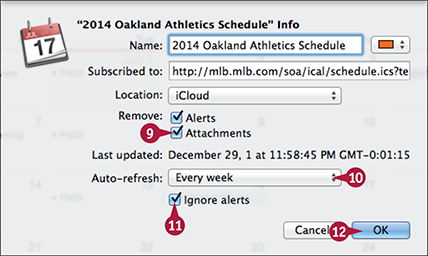
![]() Click Attachments (
Click Attachments (![]() changes to
changes to ![]() ) if you want to remove attachments.
) if you want to remove attachments.
![]() Click the Auto-refresh pop-up menu (
Click the Auto-refresh pop-up menu (![]() ) and select your preferred option for automatically refreshing the calendar, such as Every week.
) and select your preferred option for automatically refreshing the calendar, such as Every week.
![]() Click Ignore alerts (
Click Ignore alerts (![]() changes to
changes to ![]() ) if you want to ignore alerts set in the calendar.
) if you want to ignore alerts set in the calendar.
![]() Click OK.
Click OK.
Calendar adds the calendar, and its events appear.
Add a Contact
OS X’s Contacts app enables you to track and manage your contacts. Contacts stores the data for each contact on a separate virtual address card that contains storage slots for many different items of information, from the person’s name and phone numbers to the e-mail addresses and photo.
To add a contact, you create a new contact card and enter the person’s data on it. You can also add contact information quickly from vCard address card files that you receive.
Add a Contact
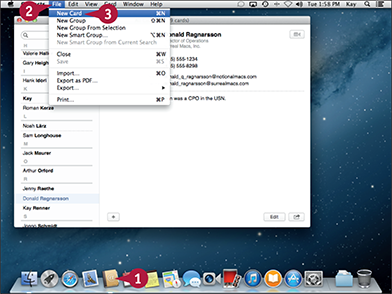
![]() Click Contacts (
Click Contacts (![]() ) on the Dock.
) on the Dock.
The Contacts app opens.
![]() Click File.
Click File.
The File menu opens.
![]() Click New Card.
Click New Card.
Note: You can also create a new contact card by pressing ![]() +
+![]() or by clicking Add (
or by clicking Add (![]() ) and then selecting New Contact from the pop-up menu.
) and then selecting New Contact from the pop-up menu.
Contacts creates a new card and selects the First placeholder.
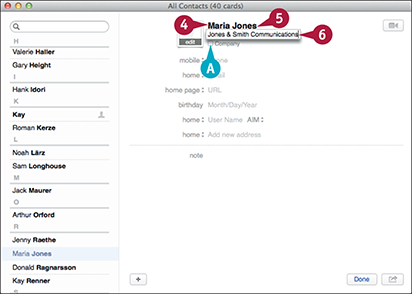
![]() Type the contact’s first name.
Type the contact’s first name.
Note: Press ![]() to move the selection from the current field to the next.
to move the selection from the current field to the next.
![]() Type the contact’s last name.
Type the contact’s last name.
![]() If the contact works for a company, type the company name.
If the contact works for a company, type the company name.
A You can click Company (![]() changes to
changes to ![]() ) when creating a card for a company or organization.
) when creating a card for a company or organization.
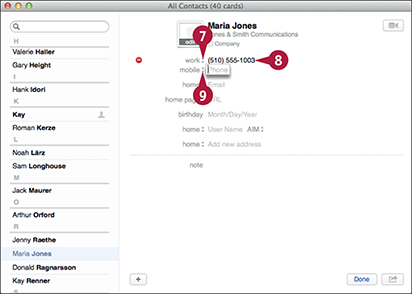
![]() Click the pop-up menu (
Click the pop-up menu (![]() ) next to the first Phone field and select the type of phone number, such as work or mobile.
) next to the first Phone field and select the type of phone number, such as work or mobile.
![]() Type the phone number.
Type the phone number.
![]() Add other phone numbers as needed.
Add other phone numbers as needed.

![]() Click the pop-up menu (
Click the pop-up menu (![]() ) next to the first Email field and select the type of e-mail address, such as work or home.
) next to the first Email field and select the type of e-mail address, such as work or home.
![]() Type the e-mail address.
Type the e-mail address.
![]() Add the physical address and other information.
Add the physical address and other information.
![]() Click Done.
Click Done.
Contacts closes the card for editing.
The card appears in the contacts list.
Note: Only the fields that contain data appear in the card.
Change a Contact’s Information
Contacts makes it easy to change the information for a contact. So when you learn that a contact’s details have changed, or you need to add extra information, you can open the contact record and make the changes needed.
Contacts enables you to add a wide variety of different fields to a contact record to store the information about a contact. You can also add a photo to a contact record.
Change a Contact’s Information
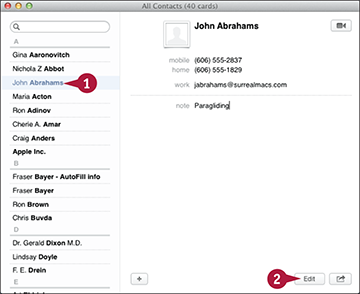
![]() In the left column in the Contacts window, click the contact whose information you want to change.
In the left column in the Contacts window, click the contact whose information you want to change.
![]() Click Edit.
Click Edit.
Contacts opens the contact’s card for editing.
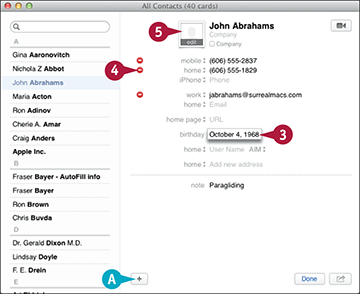
![]() To change an existing field, click it and then type the updated information.
To change an existing field, click it and then type the updated information.
A You can add a field by clicking Add (![]() ) and then clicking the field on the contextual menu or the More Fields submenu.
) and then clicking the field on the contextual menu or the More Fields submenu.
![]() To remove an existing field, click Remove (
To remove an existing field, click Remove (![]() ) next to it.
) next to it.
![]() To add a photo for the contact, double-click the picture placeholder.
To add a photo for the contact, double-click the picture placeholder.
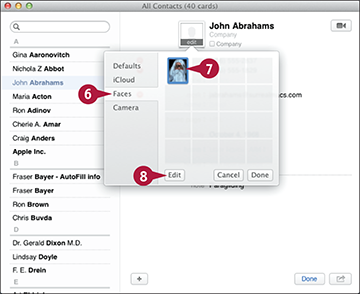
![]() Click Faces.
Click Faces.
The faces you have identified in iPhoto appear.
Note: Click Defaults to assign one of OS X’s user account pictures. Click iCloud to use a picture you have stored in iCloud. Click Camera to take a photo with your iMac’s camera.
![]() Click the face you want to use.
Click the face you want to use.
![]() Click Edit.
Click Edit.
The photo opens for editing.
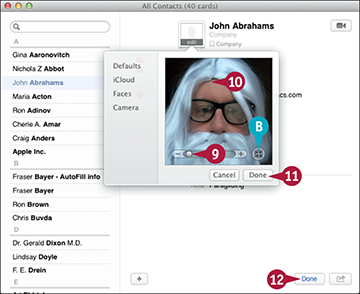
![]() Click and drag the slider to zoom in or out.
Click and drag the slider to zoom in or out.
![]() Click and drag the photo to change the part that appears.
Click and drag the photo to change the part that appears.
B You can click Effect (![]() ) to apply an effect to the photo.
) to apply an effect to the photo.
![]() Click Done.
Click Done.
Contacts adds the photo to the contact record.
![]() Click Done.
Click Done.
Contacts closes the contact record for editing.
Organize Contacts into Groups
Contacts enables you to organize your contacts into separate groups, making it easier to find the contacts you need. Groups are useful if you have several different categories of contacts, such as family, friends, and colleagues. You can assign any contact to as many groups as needed.
After creating groups, you can view a single group at a time or search within a group. You can also send an e-mail message to all the members of a group.
Organize Contacts into Groups
Create a Group of Contacts
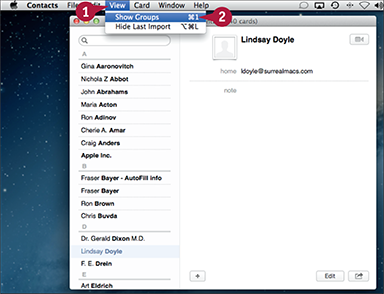
![]() In Contacts, click View.
In Contacts, click View.
The View menu opens.
![]() Click Show Groups.
Click Show Groups.
Note: You can also press ![]() +
+![]() to display the Groups pane.
to display the Groups pane.
The Groups pane opens on the left side of the Contacts window.
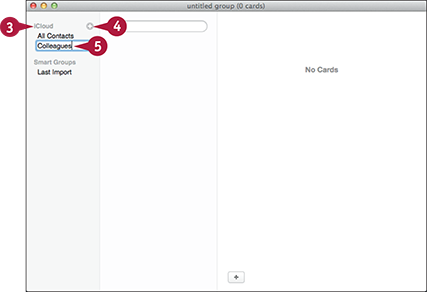
![]() Position the mouse pointer over the account in which you want to create the group, such as iCloud.
Position the mouse pointer over the account in which you want to create the group, such as iCloud.
The Add button (![]() ) appears.
) appears.
![]() Click Add (
Click Add (![]() ).
).
Contacts adds a group and displays an edit box around the default name, untitled group.
![]() Type the name and press
Type the name and press ![]() .
.
The name appears.
Add Contacts to a Group
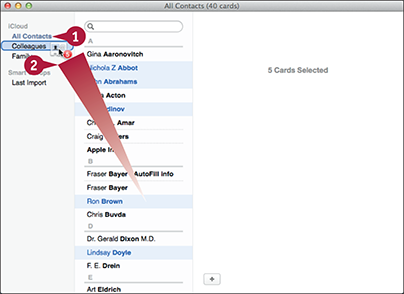
![]() Click All Contacts.
Click All Contacts.
Contacts displays all your contacts.
![]() Click and drag a contact to the new group.
Click and drag a contact to the new group.
Note: To add multiple contacts to the group, click the first, and then press ![]() +click each of the others. Click and drag the selected contacts to the group.
+click each of the others. Click and drag the selected contacts to the group.
View a Group or Search Within It
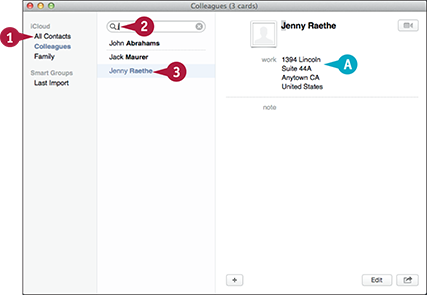
![]() Click the group.
Click the group.
Contacts displays the contacts in the group.
![]() To search within the group, click in the search box and type a search term.
To search within the group, click in the search box and type a search term.
Contacts displays matching contacts.
![]() Click the contact you want to view.
Click the contact you want to view.
A The contact’s details appear.
Create Notes
The Notes app included with OS X enables you to take text notes on your iMac. You can format the notes by using italics, boldface, indentation, and other widely used formatting. Notes are text only and cannot contain objects such as images.
If you store the notes in your iCloud account, you can access them from your iOS devices, your other Macs running OS X 10.7 or later versions, a Windows PC with the iCloud Control Panel installed, or any Windows PC or Mac that has a compatible web browser.
Create Notes
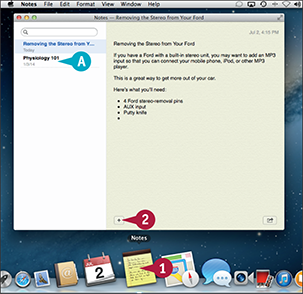
![]() Click Notes (
Click Notes (![]() ) on the Dock.
) on the Dock.
Note: If Notes (![]() ) does not appear on the Dock, click Launchpad (
) does not appear on the Dock, click Launchpad (![]() ) and then click Notes (
) and then click Notes (![]() ) on the Launchpad screen.
) on the Launchpad screen.
The Notes window opens.
A You can click an existing note to display its contents.
![]() Click Add (
Click Add (![]() ).
).
Notes creates a new blank note.
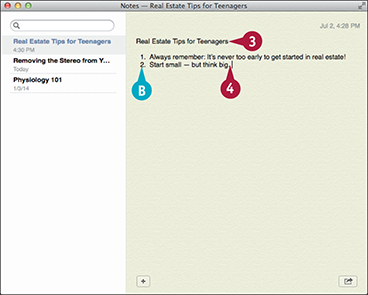
![]() Type the title of the note and press
Type the title of the note and press ![]() .
.
![]() Type the text of the note.
Type the text of the note.
B Notes automatically applies numbered-list formatting when you start a paragraph by typing a numbering format, such as 1. followed by a space or tab.
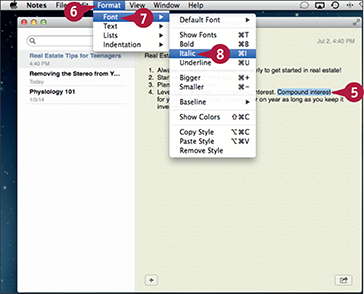
![]() Click and drag to select the text that you want to format.
Click and drag to select the text that you want to format.
![]() Click Format.
Click Format.
The Format menu opens.
![]() Highlight the submenu for the formatting you want to apply, such as Font.
Highlight the submenu for the formatting you want to apply, such as Font.
The submenu opens.
![]() Click the appropriate command, such as Italic.
Click the appropriate command, such as Italic.

C You can quickly share a note by clicking Share (![]() ) and then clicking Email This Note or Messages, as appropriate.
) and then clicking Email This Note or Messages, as appropriate.
![]() When you finish creating the note, press
When you finish creating the note, press ![]() +
+ ![]() .
.
Notes closes.
Keep Track of Tasks with Reminders
OS X’s Reminders app gives you an easy way to track what you have to do and your progress on your tasks. Reminders enables you to link a reminder to a specific time, a specific location, or both. Linking a reminder to a location is useful when you sync your reminders with a MacBook or with an iPhone, iPad, or iPod touch that you carry from location to location.
Keep Track of Tasks with Reminders
Create a Reminder
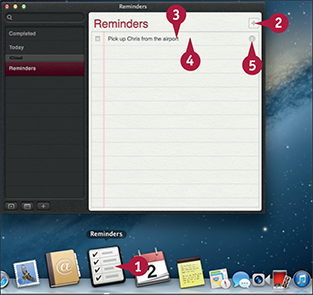
![]() Click Reminders (
Click Reminders (![]() ) on the Dock.
) on the Dock.
Note: If the Reminders icon (![]() ) does not appear on the Dock, click Launchpad (
) does not appear on the Dock, click Launchpad (![]() ), and then click Reminders (
), and then click Reminders (![]() ).
).
The Reminders window opens.
![]() Click Add (
Click Add (![]() ).
).
Reminders starts a new reminder.
![]() Type the description of the reminder.
Type the description of the reminder.
![]() Position the mouse pointer over the reminder.
Position the mouse pointer over the reminder.
The Info button (![]() ) appears.
) appears.
![]() Click Info (
Click Info (![]() ).
).
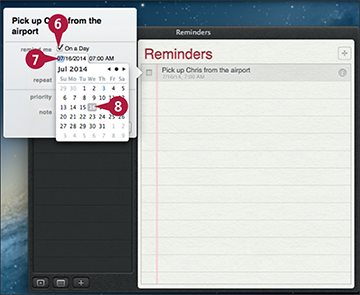
![]() Click On a Day (
Click On a Day (![]() changes to
changes to ![]() ).
).
The date and time controls appear.
![]() Click the date.
Click the date.
The date panel opens.
![]() Double-click the date for the reminder.
Double-click the date for the reminder.
The date panel closes, and the date appears in the Info panel.
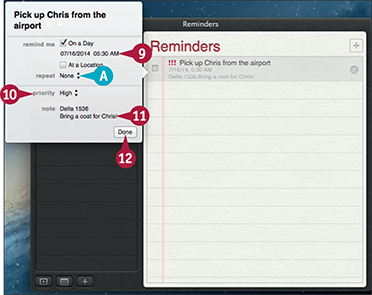
![]() Type the time for the reminder.
Type the time for the reminder.
A You can click repeat to set up a repeating reminder.
![]() Click the priority pop-up menu (
Click the priority pop-up menu (![]() ) and select the priority: None, Low, Medium, or High.
) and select the priority: None, Low, Medium, or High.
![]() Click note and type any notes needed for the reminder.
Click note and type any notes needed for the reminder.
![]() Click Done.
Click Done.
The Info panel closes.
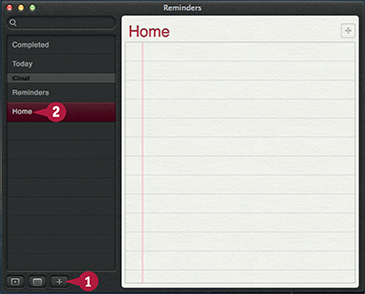
![]() In Reminders, click New List (
In Reminders, click New List (![]() ).
).
Note: If the sidebar is hidden, click View and select Show Sidebar.
A new list appears in the sidebar.
![]() Type the list’s name.
Type the list’s name.
![]() Press
Press ![]() .
.
The list appears, and you can start adding reminders to it.
Note: You can click and drag an existing reminder to the list in the sidebar.
Find Directions with Maps
OS X’s Maps app enables you to pinpoint your iMac’s location by using known wireless networks. You can view your location on a road map, a satellite picture, or a hybrid that shows street annotations on the satellite picture. You can easily switch among map types to find the most useful one for your current needs.You can use Maps to get directions to where you want to go. In some areas, you can also display current traffic congestion to help you identify the most viable route for a journey.
Find Directions with Maps
Open Maps and Find Your Location
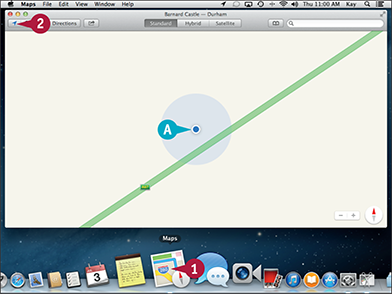
![]() Click Maps (
Click Maps (![]() ) on the Dock.
) on the Dock.
Note: If Maps (![]() ) does not appear on the Dock, click Launchpad (
) does not appear on the Dock, click Launchpad (![]() ) on the Dock and then click Maps (
) on the Dock and then click Maps (![]() ) on the Launchpad screen.
) on the Launchpad screen.
The Maps window opens.
![]() Click Current Location (
Click Current Location (![]() changes to
changes to ![]() ).
).
A A blue dot shows your current location. The blue circle indicates that Maps is determining your location.
Change the Map Type and Zoom In or Out

![]() Click Hybrid.
Click Hybrid.
The map switches to Hybrid view, showing satellite images with place names.
![]() Click Zoom Out (
Click Zoom Out (![]() ) one or more times.
) one or more times.
The map zooms out.
Note: Click Zoom In (![]() ) to zoom in.
) to zoom in.
Note: You can rotate the map by pressing ![]() +clicking and dragging. To return the map to its default northward orientation, click the compass arrow (
+clicking and dragging. To return the map to its default northward orientation, click the compass arrow (![]() ).
).
Get Directions
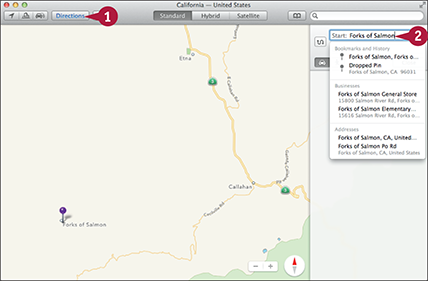
![]() Click Directions.
Click Directions.
The Directions pane opens, suggesting Current Location as your starting point.
![]() Type your start point.
Type your start point.
Note: If Maps displays a panel of suggestions for the start point or end point you type, click the appropriate suggestion.
Note: Click View on the menu bar and then click Show Traffic to display traffic conditions if they are available.
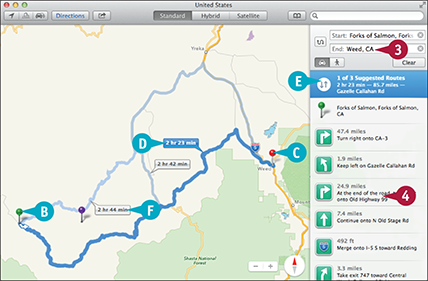
Maps displays suggested routes.
B The green pin marks the start.
C The red pin marks the end.
D The current route appears in darker blue.
E The current route’s details appear in the Directions pane.
F You can click another route or its time box to display its details.
![]() Click a direction to display that part of the route.
Click a direction to display that part of the route.
Explore with Maps
The Maps app enables you not only to find out where you are and get directions to places, but also to explore with 3-D flyovers of the places on the map.
To use 3-D flyovers, you navigate to the place you want to explore, and then switch on the 3D feature. You can then zoom in and out on the map, pan around, and move backward to forward.
Explore with Maps

![]() Click Maps (
Click Maps (![]() ) on the Dock.
) on the Dock.
Note: If Maps (![]() ) does not appear on the Dock, click Launchpad (
) does not appear on the Dock, click Launchpad (![]() ) on the Dock and then click Maps (
) on the Dock and then click Maps (![]() ) on the Launchpad screen.
) on the Launchpad screen.
The Maps window opens.
![]() Display the area of interest in the middle of the screen by browsing or searching.
Display the area of interest in the middle of the screen by browsing or searching.
![]() Click Flyover (
Click Flyover (![]() changes to
changes to ![]() ).
).
The map switches to Flyover view.
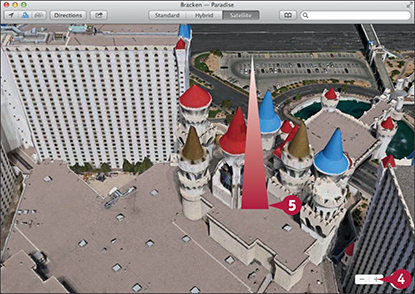
![]() Click Zoom In (
Click Zoom In (![]() ) to zoom in.
) to zoom in.
![]() Click and drag to scroll the map.
Click and drag to scroll the map.

![]() Press
Press ![]() +click and drag clockwise or counterclockwise.
+click and drag clockwise or counterclockwise.
The view rotates, and you can explore.
Note: Pan and zoom as needed to explore the area.

A The red end of the compass arrow (![]() ) indicates north. You can tap this icon to restore the direction to north.
) indicates north. You can tap this icon to restore the direction to north.
![]() Click Flyover (
Click Flyover (![]() changes to
changes to ![]() ).
).
The map returns to normal view.
